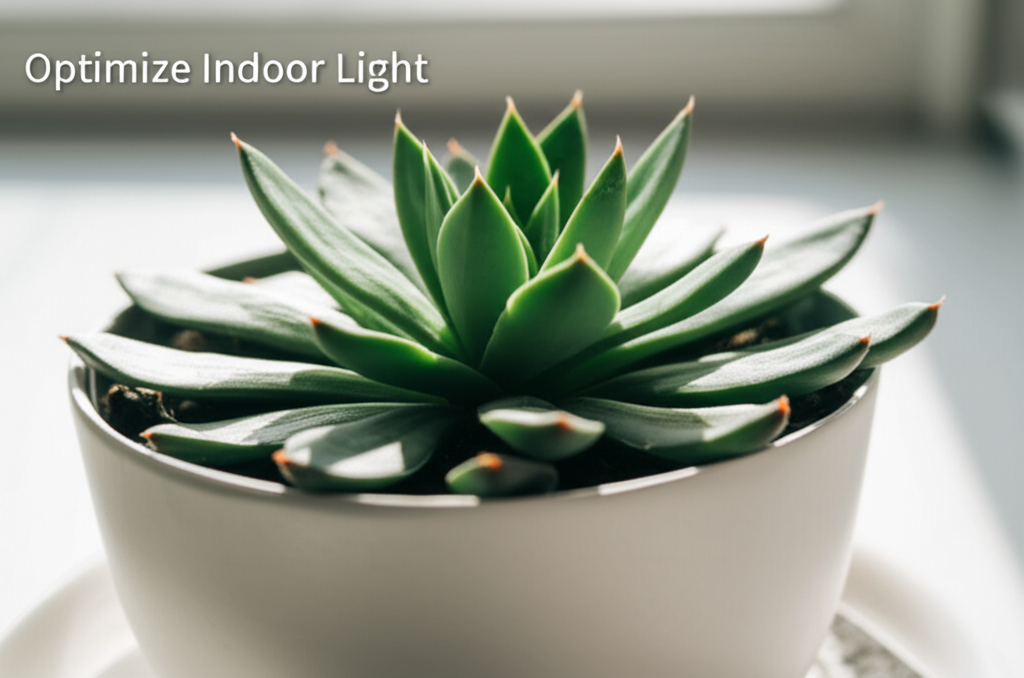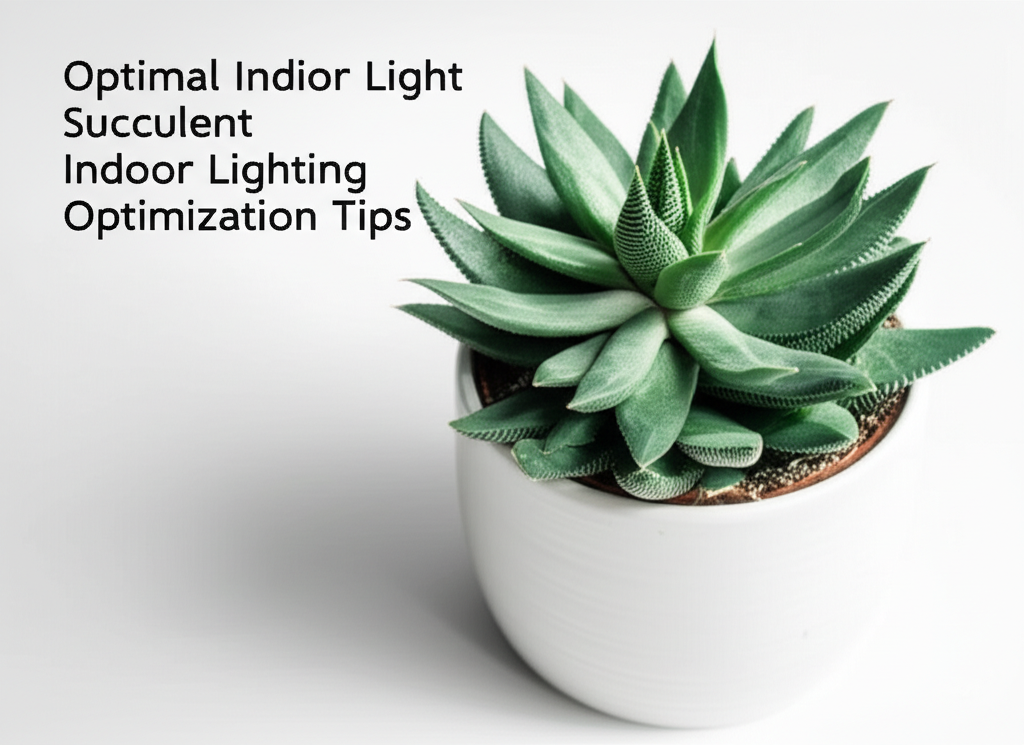The Dazzling Delight: Understanding Ice Plant Succulents
Ice plants, scientifically known as members of the Aizoaceae family, are a fascinating group of succulents renowned for their unique, crystal-like structures that adorn their leaves. These epidermal “bladders,” or papillae, refract light, giving the plants a frosted or dewy appearance, hence the name “ice plant.” While many varieties thrive outdoors in arid or Mediterranean climates, their striking beauty makes them a popular choice for indoor cultivation. However, replicating their ideal natural environment indoors, particularly when it comes to lighting, can be a challenge. Optimizing the lighting for your ice plant is crucial for its health, vibrant coloration, and ability to produce those characteristic sparkly structures.
Why Lighting is Paramount for Ice Plants
Indoor environments often present a stark contrast to the bright, sunny conditions that ice plants naturally seek. Insufficient light can lead to a host of problems, including:
- Legginess (Etiolation):
- Loss of Color: Many ice plant varieties display vibrant hues – reds, oranges, purples – when exposed to adequate sunlight. Low light conditions will cause these colors to fade, leaving the plant a duller green.
- Reduced Bladder Development: The signature crystalline papillae are a direct response to intense sunlight. Without enough light, these structures will be smaller, less numerous, and less pronounced.
- Weakened Overall Health: Proper lighting is essential for photosynthesis, the process by which plants convert light energy into food. Inadequate light weakens the plant, making it more susceptible to pests and diseases.
Assessing Your Indoor Lighting Environment

Before diving into optimization strategies, it’s vital to understand the natural light your home offers. Different rooms and windows receive varying amounts and intensities of light throughout the day and year.
Window Direction: Your First Clue
The orientation of your windows plays a significant role in the amount of sunlight received.
- South-facing windows: In the Northern Hemisphere, these windows receive the most direct sunlight throughout the day, making them ideal for light-loving succulents like ice plants.
- East-facing windows: These windows provide bright morning sun, which is beneficial but less intense than midday sun.
- West-facing windows: West-facing windows receive direct afternoon sun, which can be quite intense, especially during summer months. This can be good, but may require shading during the hottest part of the day to prevent scorching.
- North-facing windows: These windows offer the least amount of direct sunlight, receiving only indirect light. This is generally insufficient for most ice plants.
Light Intensity and Duration
It’s not just about the direction, but also the quality and quantity of light. Ice plants generally thrive in bright, indirect light for at least 6-8 hours per day. Direct, scorching midday sun, especially through glass, can sometimes be too much for certain varieties, leading to leaf burn.
Obstructions and Seasonal Changes
Consider any external obstructions like trees or buildings that might block sunlight, especially during winter months when the sun is lower in the sky. Seasonal changes will naturally alter the amount of light entering your home.
Optimizing Light for Your Ice Plant
Once you’ve assessed your current lighting situation, you can implement strategies to provide your ice plant with the ideal light conditions.
Strategic Placement
The simplest and most effective method is to place your ice plant in the brightest location available.
- Prioritize south-facing windows.
- If south-facing isn’t an option, an east-facing window can work, especially if supplemented.
- Be cautious with west-facing windows; monitor for signs of scorching.
Supplementing Natural Light with Grow Lights
For many indoor growers, relying solely on natural light isn’t enough. Grow lights are an invaluable tool for supplementing or even replacing natural light.
Types of Grow Lights
- LED Grow Lights: These are the most popular choice for home growers due to their energy efficiency, long lifespan, and customizable light spectrum. They produce less heat than other types, reducing the risk of scorching your plants.
- Fluorescent Grow Lights: While older technology, fluorescent lights (particularly T5 high output bulbs) can be effective for succulents, offering a good spectrum of light. They are less energy-efficient than LEDs and may require replacement more frequently.
- Incandescent Grow Lights: These are generally not recommended for plant growth as they produce too much heat and an unbalanced light spectrum, favoring red wavelengths which can encourage leggy growth.
Choosing the Right Spectrum
Succulents, including ice plants, benefit from a balanced light spectrum.
- Full Spectrum: Mimics natural sunlight and provides all the necessary wavelengths for healthy growth, including blue and red light.
- Blue Light: Crucial for vegetative growth and compact development.
- Red Light: Important for flowering and overall plant development, though too much can lead to stretching.
Most modern LED grow lights offer “full spectrum” options, which are excellent for ice plants. Look for lights with a color temperature (Kelvin) between 5000K and 6500K for optimal growth.
Light Duration and Intensity Control
- Duration: Aim for 10-14 hours of supplemental light per day. Use a timer to ensure consistency.
- Intensity: Position the grow light at an appropriate distance from your plant. For most LED grow lights, this can be anywhere from 6 to 18 inches, depending on the light’s wattage and your plant’s sensitivity. Observe your plant for signs of stress (scorching) or insufficient light (stretching) to adjust the distance.
Key Factors for Ice Plant Succulent Lighting
Here’s a quick overview of the critical elements to consider when providing light for your ice plant:
| Factor | Ideal Condition for Ice Plants | Impact of Insufficient Light | Impact of Excessive/Harsh Light |
|---|---|---|---|
| Light Intensity | Bright, indirect to moderate direct sunlight | Legginess, faded color, poor bladder development | Leaf scorching, wilting, browning |
| Light Duration | 6-8 hours of natural light OR 10-14 hours of supplemental light | Slow growth, weak structure | Can be beneficial if not too harsh, but monitor for stress |
| Light Spectrum | Full spectrum (balanced blues and reds) | Stunted growth, lack of coloration | Generally not an issue with proper intensity |
| Consistency | Regular and predictable light exposure | Stress, uneven growth | Stress, uneven growth |
Troubleshooting Common Lighting Issues
Even with the best intentions, you might encounter problems. Here’s how to diagnose and fix them:
Problem: My ice plant is stretching and looks pale.
- Diagnosis: Insufficient light.
- Solution:
Move the plant to a brighter location.
Increase the duration of supplemental grow light.
Lower the grow light closer to the plant (if using one).
Problem: My ice plant has brown, crispy spots on its leaves.
- Diagnosis: Sunburn or excessive heat from direct sunlight, especially through glass.
- Solution:
Move the plant away from direct, intense midday sun.
If using grow lights, raise them further away from the plant.
Consider using sheer curtains to filter harsh light.
Problem: The crystalline structures are not developing.
- Diagnosis: Insufficient light intensity or duration.
- Solution:
Increase the overall light exposure, focusing on intensity.
Ensure the plant is receiving at least 6-8 hours of bright light daily.
* Experiment with moving the grow light slightly closer, observing for any signs of stress.
Step-by-Step Guide to Lighting Optimization
Follow these steps to ensure your ice plant receives the best possible light indoors:
- Assess your current light: Identify your brightest windows and note the direction they face.
- Initial placement: Position your ice plant in the most suitable natural light location (ideally south-facing).
- Observe your plant: Monitor for signs of legginess, color loss, or scorching over a week or two.
- Introduce supplemental lighting (if needed): Select an appropriate LED grow light and timer.
- Determine grow light distance: Start with the manufacturer’s recommendation or around 12 inches and adjust as needed.
- Set light duration: Program your timer for 10-14 hours of light per day.
- Monitor and adjust: Continue to observe your plant’s response and make adjustments to light placement, intensity, or duration.
- Consider seasonal shifts: Be prepared to adjust lighting as daylight hours change throughout the year.
Pros and Cons of Different Lighting Strategies
Here’s a balanced view of the approaches to lighting optimization:
| Strategy | Pros | Cons |
|---|---|---|
| Natural Light Only | Free, readily available, balanced spectrum | Limited by window availability and intensity, inconsistent throughout the year |
| Supplemental Grow Lights | Provides consistent and optimal light, allows for placement flexibility, promotes vibrant growth and coloration | Initial cost of equipment, requires electricity, can increase room temperature, needs proper setup and monitoring |
| Combination (Natural + Supplemental) | Maximizes benefits of both, can be more energy-efficient than full artificial light | Requires careful balancing to avoid over-lighting or under-lighting |
Conclusion: A Bright Future for Your Ice Plant
Providing the right lighting for your ice plant succulent is not just about keeping it alive; it’s about enabling it to thrive and showcase its full, glittering potential. By understanding your environment, strategically placing your plant, and utilizing grow lights when necessary, you can create an indoor oasis that mimics its native habitat. Consistent observation and a willingness to adjust your approach are key to unlocking the dazzling beauty of these unique succulents, ensuring they bring a touch of frosty wonder to your home.


